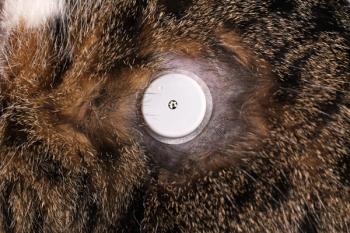
Research Updates: Do glucosamine-based chondroprotective agents affect fructosamine monitoring in diabetic dogs?
This study demonstrated that short-term administration of glucosamine-chondroitin sulfate does not significantly affect serum fructosamine concentrations in healthy dogs.
Glucosamine is a precursor of glycosaminoglycans, a major component of normal cartilage matrix. Supplementation with a combination of glucosamine and chondroitin sulfate ameliorates signs of osteoarthritis in dogs and people and is commonly prescribed to veterinary patients with suspected or confirmed degenerative joint disease. However, because glucosamine is composed of glucose and glutamine, administration of such chondroprotective agents could, in theory, increase serum glucose concentrations and thereby increase an animal's insulin requirements even further or, alternatively, could be contributing to pancreatic beta cell death by worsening hyperglycemia-associated glucose toxicity.
Getty Images/Image Source
Fructosamine, which is formed by the nonenzymatic glycosylation of albumin, is often measured when monitoring insulin therapy in diabetic dogs. Increases in serum fructosamine concentration in most cases are due to sustained hyperglycemia, so results above the reference range in a diabetic patient usually imply inadequate insulin dosing. The goal of this study was, therefore, to determine the impact of oral glucosamine-chondroitin sulfate supplementation on fructosamine concentrations in healthy dogs and, thereby, provide preliminary data on whether clinicians should consider the impact of this agent on monitoring protocols in diabetic patients.
Twelve healthy adult dogs were enrolled in this prospective, blinded, crossover study. Dogs fed a therapeutic diet designed to treat joint disease were excluded from enrollment because these diets may contain an undetermined amount of glucosamine. Six dogs (group 1) were randomly allocated to receive glucosamine-chondroitin sulfate once daily at the manufacturer's recommended dose for three weeks, and six dogs (group 2) were randomly allocated to receive a placebo (microcrystalline cellulose) once daily incorporated into an identical capsule for three weeks. Serum fructosamine concentrations were measured in all dogs before and at the end of the treatment period.
After completion of the first three-week study period, the glucosamine-chondroitin sulfate and placebo were discontinued in all dogs, and following a four-week washout period, group 1 dogs were then administered the placebo for three weeks, while group 2 dogs received the chondroprotective agent, again with measurement of serum fructosamine concentrations before and after treatment. Statistical analysis revealed that there was no difference in mean fructosamine concentrations before or after administration of glucosamine-chondroitin sulfate or placebo, and no significant difference was seen between fructosamine concentrations observed in dogs receiving the chondroprotective agent vs. the placebo.
COMMENTARY
This study demonstrated that short-term administration of glucosamine-chondroitin sulfate does not significantly affect serum fructosamine concentrations in healthy dogs. Although a previous study had determined that administration of a chondroprotective agent to healthy dogs for 30 days does not increase serum glucose concentration,1 direct confirmation that serum fructosamine concentrations were likewise unaffected was necessary because of the effects of this class of drugs on glucose homeostasis in different mammalian species.
For example, glucosamine induces insulin resistance in rats but not in healthy people or those with type 2 diabetes mellitus,2 likely because the conversion of glucose and glutamine to glucosamine is irreversible in humans and is, therefore, unlikely to result in hyperglycemia2 ; whether or not the same is true in dogs is unknown.
Because of this uncertainty, one could theorize, for example, that if glucosamine-derived serum glucose in dogs were to somehow be preferentially and rapidly bound to serum albumin, this would result in normal serum glucose but increased serum fructosamine concentrations. Therefore, any suggested redundancy of this study with previous investigations of glucose homeostasis in dogs administered chondroitin-based supplements is not justified.
Despite this justification for directly determining whether fructosamine concentrations are affected by short-term administration of glucosamine-chondroitin sulfate, two important limitations of this study prevent definitively stating that glucosamine-chondroitin sulfate supplements will have no effect on glucose homeostasis. First, the effect of this supplement on serum fructosamine concentrations was studied in healthy dogs rather than in dogs with diabetes mellitus. Several metabolic pathways (i.e. not just glucose homeostasis) are altered in patients with this disease, and, as such, glucosamine catabolism and biologic activity of any drug metabolites could in theory differ between these two populations. Second, chondroprotective agents are often administered for months to years rather than the 30-day period described in this study. Effects of glucosamine-chondroitin sulfate on glucose homeostasis may in theory be cumulative rather than immediate, so further studies that examine the type and importance of drug-associated effects following long-term administration are warranted.
Finally, although only hypothetical, chondroprotective agents such as glucosamine may have additional adverse effects that are unrelated to alterations in serum glucose concentration or homeostasis. This is a concern because glycosaminoglycans (such as heparin) are known substrates in or modulators of a number of unrelated metabolic processes. In fact, prolongation of several coagulation parameters two hours after parenteral administration of polysulfated glycosaminoglycans has been reported in dogs,3 although a later study failed to detect alterations in PT, APTT, or BMBT.1 Practitioners should keep in mind that this class of drugs has the potential for a wide range of adverse effects, particularly those agents classified as supplements, which may not have undergone rigorous toxicity studies.
The information in "Research Updates" was provided by Erika Meler, DVM, MS, and Barrak Pressler, DVM, PhD, DACVIM, Department of Veterinary Clinical Sciences, School of Veterinary Medicine, Purdue University, West Lafayette, IN 47907.
REFERENCES
1. Beale BS, Goring RL, Clemmons RM, et al. The effects of semi-synthetic polysulfated glycosaminoglycan on the hemostatic mechanism in the dog [abstr]. Vet Surg 1990;19:57.
2. McNamara PS, Barr SC, Erb HN. Hematologic, hemostatic, and biochemical effects in dogs receiving an oral chondroprotective agent for thirty days. Am J Vet Res 1996;57(9):1390-1394.
3. Scroggie DA, Albright A, Harris MD. The effect of glucosamine-chondroitin supplementation on glycosylated hemoglobin levels in patients with type 2 diabetes mellitus: a placebo-controlled, double-blinded, randomized clinical trial. Arch Intern Med 2003;163(13):1587-1590.
Newsletter
From exam room tips to practice management insights, get trusted veterinary news delivered straight to your inbox—subscribe to dvm360.




